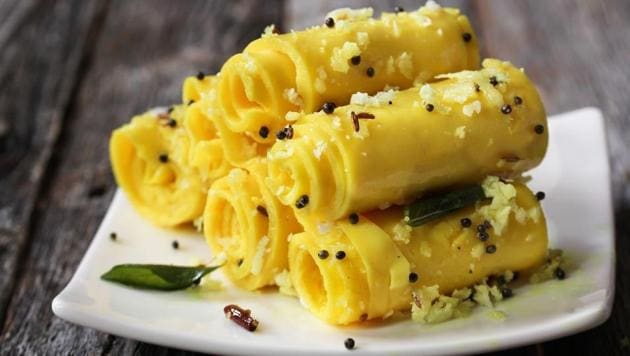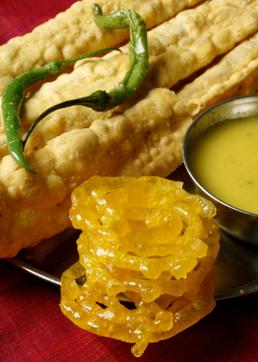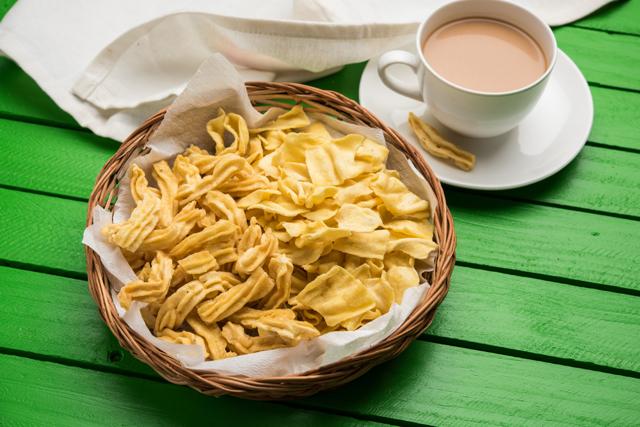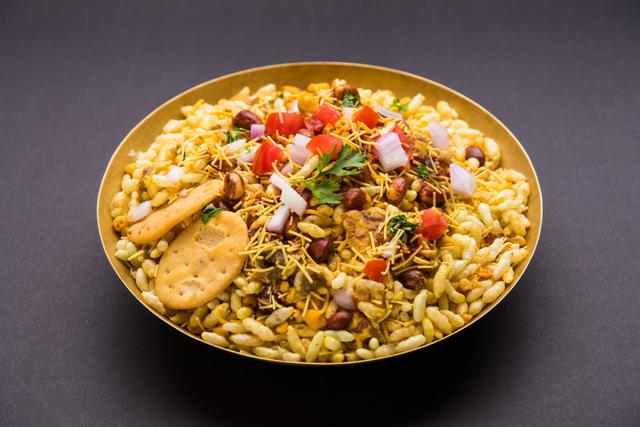The Taste with Vir Sanghvi: Gujaratis are the greatest Indian travellers (and fussiest eaters)
In this week’s column, Vir Sanghvi reconnects with his Gujarati heritage and discusses the most popular Gujarati snacks - and why travelling all the way to Kerala and eating gaanthia might not be such a strange thing after all.
Of all of India’s states, there is no doubt that the best food is in Kerala. This has always been my position and after visiting Cochin last week, I have no reason to deviate from it. I ate all over the city (but you’ll have to wait for Brunch in a couple of weeks to get the details of those meals) and the chefs at the new Grand Hyatt served me perfect breakfasts day after day: everything from fluffy idlis to delicious egg roast (made with little quail’s eggs) and appams.

And yet, the Gujarati in me could not be suppressed. We were passing the Gujarati area of Fort Cochin when our guide pointed out Shantilal Mithaiwala, a local institution and --- more importantly – a mithai and farsan shop run by Gujaratis. Naturally, I went inside, tried the boondi ka laddoo (delicious) and settled on the paapri ganthia, a besan snack much favoured by my people. (There has been some controversy on Instagram about the picture I posted. Were these really ganthias? That’s what the sceptics wanted to know. Yes they were. Gaanthia is a generic term for two or three kinds of snack and both me and the guys at the shop called them gaanthias.)
Then, I tried the jalebis and decided to go the whole hog and bought half a kilo of them. The next morning, the good people at the Grand Hyatt kitchen were bemused to be told that I needed no breakfast from their chefs. But could they heat my jalebis and serve them with the gaanthia please?

Hotels are used to strange requests so nobody said anything. And as I had bought so many gaanthias, I was able to introduce my Punjabi wife to the delights of Gujarati snacks (she loved them) and that afternoon we watched the Karnataka Confidence Vote — which was essentially a Gujarat vs Karnataka contest – on TV while gorging on gaanthias. And though Gujarat lost the vote, we didn’t mind; all I could focus on were the gaanthias!
Afterwards, when I posted the photos on social media, the criticisms and the expressions of astonishment began to pour in. Shabhana Azmi asked me on Twitter, why I went all the way to Kerala to eat gaanthias. And others suggested --- probably fairly --- that I had to be a bit of an idiot to go as far as Cochin to eat Gujarati snacks.
But what to do? We Gujaratis are like this only.
Look at any party of touring Gujaratis. Unless they are the super-sophisticated types, they will have packed Khakras, theplas, garlic chutney, mango pickle and perhaps even some khaari poori. No matter where they go, no matter how bad the food is, Gujaratis will never go hungry. Because there is always a thepla-gaanthia stash hidden away somewhere in their baggage.
The two communities that are the greatest Indian travellers are Bengalis and Gujaratis. Bengalis eat anything so they can eat pretty much all the food that is served up to them. Gujaratis tend to be fussier. Not only are most of us vegetarians, we also like our own cuisine. Then there are the Gujarati Jains who will not eat onions or garlic making it virtually impossible for them to find much to eat when they travel.
I suspect that the Indian package tour industry only took off in the late 1970s when travel agents started sending groups of Gujaratis abroad. The great attraction for the travellers was not the thrill of going with friends or having a guide to explain the wondrous sights to them. It was that canny travel agents began sending a maharaj along with each group. So no matter where the travelling Gujaratis were --- Hong Kong, Los Angeles or Paris --- they would settle down to a meal of dal-bhaat-rotli-shaak every day.
But don’t knock it. When we are travelling, all Indians discover the pleasures of Gujarati food. In the 1990s I travelled to the Caribbean with Amitabh Bachchan and a group of movie stars who were touring the islands performing live shows.
Though the troupe had all the biggies from that era—Sridevi, Anil Kapoor, Anupam Kher and so many others —- the stars of the group were the Kalyanji-Anandji contingent. This was not just because Anandjibhai and his musicians were very good. It was also because their group included ladies who made fresh Gujarati food every day; yes, dal, bhaat, rotli, shaak. Amitabh is a vegetarian so he gravitated towards their food naturally. But so did everyone else in the troupe.

To some extent all communities are as particular about their food. So are people of all nationalities. The Japanese, for instance, are notorious for refusing to travel to places where there are no Japanese restaurants. In the 1980s and the 1990s, they all flocked to Hawaii and to Bangkok because Japanese food was readily available.
The Indian government was told by the Japanese authorities that not only would no Japanese tourists come to India but even businessmen and technical experts would stay away unless they could guarantee them Japanese food. And so, in the late 1980s, ITDC was made to open a Japanese restaurant at Delhi’s Ashoka Hotel for Japanese visitors.
Much later, at the beginning of this century, the Metropolitan Hotel tied up with Japan’s Nikko group to open Sakura, probably the first authentic, high quality Japanese restaurant in India. It was packed out day after day with Japanese businessmen. A few years later, ITC, which had found little success with Japanese food at its Pan-Asians, opened the excellent and authentic Edo in Bangalore and flourished on the basis of Japanese custom. (But if you want non-fancy, every day Japanese food then Matsuri at the Chancery Hotel in Bangalore is the place to go to.)
For Indians travelling abroad, the situation is complicated by the huge variety of inauthentic Indian food available abroad. We get ‘Indian’ food and yet we don’t.
When I was a student in England, I was appalled by the food at the Bangladeshi curry houses that constituted the vast majority of ‘Indian’ restaurants and the authentic places (Shezan, Gaylord, etc.) were all too expensive. Finally, I discovered the Diwana Bhelpuri House and other such modest places run by Gujaratis (from East Africa, mainly) for other Gujaratis.
Even now, authentic Indian food is hard to come by in England (hard as this may be to believe) unless the restaurant is run by Indians and aims higher than the curry house market. I have stayed at four or more London hotels where they have put Indian food on the room service menu in the hope of pleasing Indian high-rollers. Without exception, it has been revolting and entirely inauthentic. (The only exception is the obvious one: the Taj-run St. James Court where the room service Indian food is terrific.)
I often wonder if other communities miss their own food as much as Gujaratis do. Every North Indian I know will admit that unless he has something that tastes authentically Indian, he goes off the rails within a week or so. In most cases, it is dal (for some reason!) that seems to satisfy the Indian food craving.
For South Indians, it is curd that they miss the most. (Packaged Western-style yoghurt does not seem to do the trick.) For Bengalis it is rice. And for most Indians from every part of the country, even the hardcore non-vegetarians, the food they seem to miss the most is home-style vegetarian.

I am a little unusual in that respect. Unlike the average Gujarati, I don’t really miss dal-bhaat-rotli-shaak. The food that really gets me excited is chaat. Left to myself, I could eat chaat at every meal. The only times I feel like Indian food when I am travelling is when I crave a dahi-batala-puri or a bhel. For many years, whenever I stayed in that part of London, the Masala Zone on Marshal Street was my canteen. All of the food there was very good. But I stuck to the chaat.
Why do you suppose that is?
I guess it boils down, once again, to being a Gujarati. Some of us miss dhoklas and dahi-wadi (khandvi). But I like bhelpuri, possibly the greatest Gujarati dish ever invented. And I crave the flavours of Gujarati-style Mumbai chaat. When I am in Mumbai, and I have time to myself, its not the fancy Japanese/Chinese/Italian restaurants I will go to.
You’ll find me at Soam in Babulnath, eating the food of my people and forgetting about Michelin star chefs as I wolf down the bhel!
From gaanthia to Bhel, it is the food of my people that keeps reminding me of who I am.
Catch your daily dose of Fashion, Health, Festivals, Travel, Relationship, Recipe and all the other Latest Lifestyle News on Hindustan Times Website and APPs.




